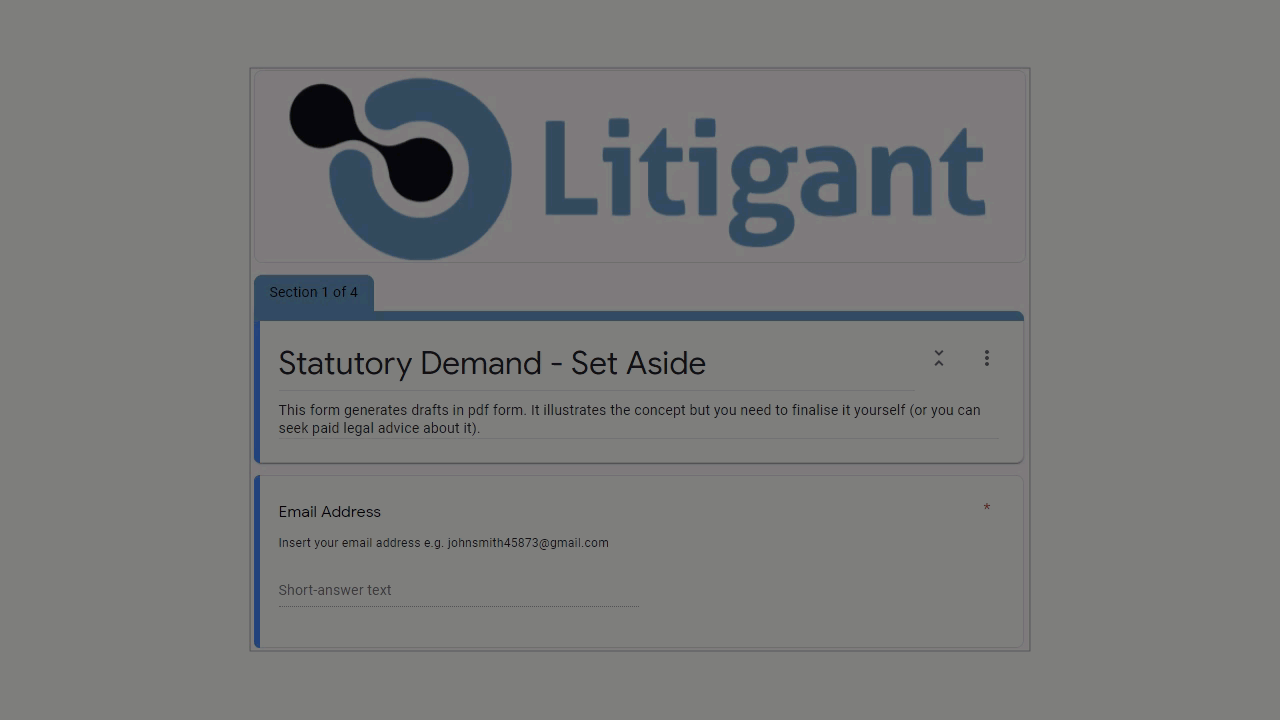
Template to Set Aside A Statutory Demand in NSW
This template to set aside a statutory demand is prepared on the basis of information you submit after you have purchased it.
Why Set Aside a Statutory Demand?
A statutory demand is used to collect unpaid liquidated debts e.g. judgement debt or unpaid invoices about which there is no dispute. Sometimes there is a dispute about payment and if the statutory demand is not set aside then there will be a presumption that the debtor company in the statutory demand is insolvent. As such it may be necessary to formally go about setting aside the statutory demand.
This template to set aside a statutory demand aims to take away some of the pain that goes into trying to set aside a statutory demand.
Steps Involved - Set Aside a Statutory Demand
- Buy the template to set aside a statutory demand;
- You will be redirected to the form page (and also be given user access for 7 days);
- Complete the form; and
- The following PDF's will be sent to you:
- letter to creditor seeking informal resolution
- court application seeking orders to set aside the statutory demand
- affidavit in support of the court application; and
- short checklist
- Use the pdf as a guide to prepare your own letter, court application and affidavit.
Jurisdiction - Originating Process and Affidavit to Set Aside a Statutory Demand for use in NSW Only
Our templates are generally designed for use by a "debtor company" located and served in NSW who want to try and set aside a statutory demand that was served upon the company within NSW. If you are located outside NSW then this template is probably not suitable.
How to Use the PDF Letter and Court Application to Try Set Aside a Statutory Demand
Use this template to articulate your position to the creditor. Failing that use the draft court application and affidavit in support to seek orders from the Supreme Court of NSW (at Sydney) for the demand to be set aside.
After you have customised the draft pdf to suit your own needs then it may be necessary to file the court documents (Originating Process and Affidavit) with the Supreme Court. The Court's applicable filing fees then need to be paid and a breakdown may be found at on the Court's website (i.e. more than $3,000). The cost of this document does not cover any such additional fees including ASIC Searches, Court Filing Fees, Process Service Fees, Hearing Allocation Fees, Briefing Counsel etc.
Do NOT use this document for statutory demands that were served outside of NSW.
Additional legal help
If you want any additional legal help, then please note that is an additional and paid service.
Disclaimer
Litigant, and its owners, servants and or agents, will not be liable for any loss suffered by your use of the precedents and or templates or guides. Such services not take into account your personal needs and circumstances and they should not be considered to constitute legal advice. Before using the precedent or template or guide on generative AI, you should consult with your own independent legal advisors, who can advise you about your personal circumstances. The precedents and or templates or guides provided seek to be in accordance with Australian law with a focus on New South Wales (NSW) and are not designed for use outside NSW, Australia or by parties located outside NSW, Australia. While Litigant tries to keep up to date with changes to the law, it is not always practically possible. Litigant, its owners, servants and agents, do not guarantee and accept no legal liability whatsoever arising from or connected to, the accuracy, reliability, currency, or completeness of any precedent or template or guide used or generated. We recommend you exercise your own skill and care with respect to the use of the precedents and or templates and or guides and that you carefully evaluate the accuracy, currency, completeness, and relevance for your purposes. Seek independant legal advice before taking any action.
